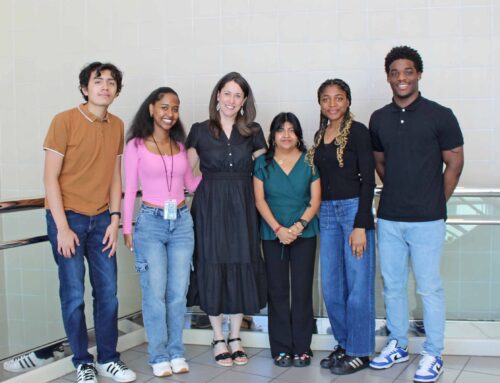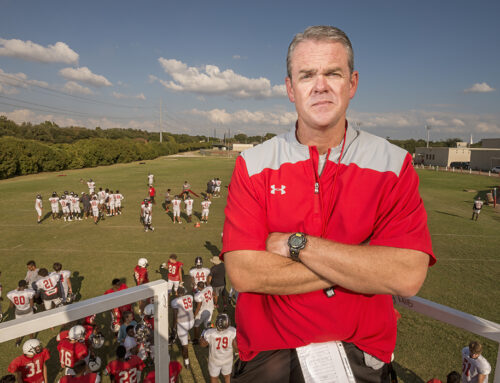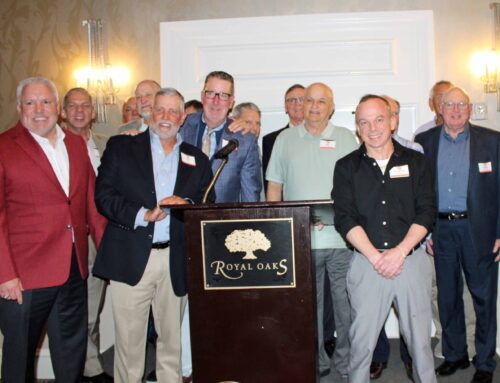Eleven-year-old Kendall Smith participated in an experiment, of sorts, for the Smith family. After several years attending a private school, Kendall enrolled last year in what her parents had been told was one of Lake Highlands’ best public elementary schools.
Several months into her first year of public school, however, Kendall found herself pushed against a wall with a fellow students’ hands gripped violently around her neck.
Experiment over. Kendall quickly joined her siblings in a private school.
“The kids have been taught to love everyone, but when you get in a situation like that, it was hard to uphold those principles,” says Connie Smith, Kendall’s mother.
Brent Worthy also attended a Lake Highlands public school.
His parents had the money to send both of their sons to private school, yet elected to send them through the public school system.
Brent also found himself in a tough situation: While attending a school-sponsored basketball game, a bunch of students from a different (non-RISD) high school began beating him up.
Brent recovered quickly from his bumps and bruises, and he’ll be graduating in May. Brent’s parents say they didn’t consider taking him out of public school.
“Things like that happen anywhere,” Sharon Worthy says. “You’re not going to find a perfect world in public or private schools.”
The Educational Dilemma
Who doesn’t want what’s best for their children?
But who really knows whether public or private school is the correct answer to that question?
The private school path, some parents believe, guarantees a good career, a well-behaved and intelligent child – in short, a pretty direct, relatively foolproof path to “what’s best for a child.”
Of course, other parents fear that private schools are breeding grounds for “bubble” kids who don’t receive a taste of the “real world”. And then, there’s the higher cost of a private school education.
Meanwhile, the public school path, some parents believe, guarantees a well-rounded, world-wise child – in short, another pretty direct, relatively foolproof path to “what’s best for a child.”
Of course, other parents fear that public schools are breeding grounds for violence, low expectations and more difficult college entrance hurdles.
We found four neighborhood families willing to tell us how they resolved these decisions for their family, and how their decisions have worked out – so far.
A Bad Brush with Public
The Smiths’ oldest child is 15 and their youngest just began kindergarten, and they’ve already spent more than $10,000 on their children’s education.
After Kendall’s one and only experience at a public elementary school, they’re convinced they’re investing their money wisely.
Today, the Smith family spends about $18,000 annually to send their children to Our Redeemer Lutheran, 7611 Park, and Lutheran High School of Dallas, 8496 Stults.
“It’s a constant struggle,” says Connie, who is a dentist. Her husband, Guy, owns his own law practice.
The Smiths believe our public schools give children exposure to all of the things that we don’t want our kids exposed to, such as drugs, violence, and lack of parent-teacher intervention.
“Some people say that’s a protective measure, and that may be true, but I’m looking for a better education,” Connie says.
Connie says she doesn’t want her kids hanging around after school in groups – where they can be exposed to drugs, says Connie, who adds that “hanging out after school” is a familiar phenomena at public schools.
Parents can prevent after school conglomerations from happening at public schools and often do, Connie says.
But Connie’s point is that private schools take the initiative to prevent shady student situations rather than leave it up to the parents to monitor.
“It gives me a sense of security that my children aren’t bombarded by negative choices, but at the same time they won’t be sheltered,” Connie says.
But there is dissension even within the Smith family ranks, The family’s two older boys, Cable and Jansen, believe public schools would be best for them. They say they’re missing out socially at their 7th – 12th-grade school, which has 250 students.
“There’s no social life at that school,” says 13-year-old Jansen about Lutheran High School.
“The school has all of these classy people who want you to be like it was a long time ago,” he says.
“We have one dance a year,” complains 15-year-old Cable, who is an avid sports player that is lacking athletic opportunity at the small private Christian school.
“I hate for them to miss the activities surrounding the sports at public schools, particularly football,” Connie says.
But she feels the drugs, violence, and lack of academic attention found in many public schools outweigh the positives.
The Public World
After Brent Worthy’s basketball game scrape, his parents could have decided to take him out of public school, but didn’t.
Overall, the Worthys are happy with their son’s public school experience, Sharon says.
Both boys attended Merriman Park Elementary, Forest Meadow Junior High and Lake Highlands High School.
The eldest son, Gavin, is a junior at University of Texas in Austin and couldn’t have been better prepared for college, Sharon says.
Gavin was enrolled in the Highlander School, 9120 Plano, through the third grade, but they decided to place him in a public school.
Highlander is an excellent elementary school, Sharon says, but at the time, the school concentrated heavily on language arts. Highlander School curriculum still concentrates strongly on Language Arts, says Highlander School President Wayne Woodring. But most of the Highlander students place into advanced math classes in junior high, he says, because the school’s curriculum keeps the students’ math classes one year ahead of their current grade level.
Gavin wasn’t happy there because he is a more math- and science-oriented student, Sharon says.
The family talked to people throughout Dallas about different public school systems and decided Lake Highlands had the best public schools, Sharon says. So the family moved to Lake Highlands for their boys’ education, Sharon says.
They considered private school again when Gavin was nearing high school – primarily because they could afford a private school, and they wanted Gavin to know he had a choice, Sharon says. Gavin decided he wanted to stay in public school, Sharon says.
“He wanted to go to the neighborhood school and be with neighborhood friends,” Sharon says.
Sharon says she wasn’t worried that he wasn’t receiving enough academic attention. Both her sons enrolled in honors classes and always felt challenged, she says.
The Worthys have always had one working parent, Richard Worthy, who worked with the Dallas County District Attorney’s office for eight years, and now owns his own finance company, MetroInk.
She does say if they didn’t live in the Lake Highlands area, the Worthys would be more inclined to send their kids to private school because Sharon feels the parent involvement is lacking in many other area public school systems.
But Sharon says she believes that her children, who both played for the Lake Highlands football team, made the right choice.
“Public school broadens your education,” Sharon says. “You’re not just learning academics, you’re learning how to get along with all kinds of people.”
Private Eyes
SMU professors and neighborhood residents Carolyn Sargent and David Freidel are confident the Hockaday School is providing a diverse environment for their 13-year-old daughter, Jennifer.
The Hockaday school has 1,000 students and they are all female.
The school has 113 Asian students, 49 African-Americans, 41 Hispanics, and one Native American, and 796 Caucasians.
To send a 13-year-old to Hockaday for one year costs $11,800.
The couple is paying that fee every year, on top of the $15,000 a year they pay to send their other daughter to the University of Pennsylvania.
Both say they don’t trust our public schools to give Jennifer a challenging and broad education.
Both parents admit that when Jennifer first entered Hockaday in fifth-grade, she had some difficulty going to school with some of the extremely wealthy students.
“At first, she was afraid to have people over because she was afraid our house was not fancy enough,” Carolyn says.
Eventually, Jennifer began to invite girls over from a group of friends she had made whom she felt comfortable with.
Before Hockaday, Jennifer attended a Montessori School and entered White Rock Elementary as a kindergartner, Carolyn says.
Jennifer was bored but she still received the highest marks possible at White Rock Elementary, Carolyn says.
Both parents agree the teachers Jennifer had at White Rock Elementary School were wonderful, but they have to teach to the most struggling student rather than the smartest ones.
“Teachers would say quite explicitly that we don’t have time to spend with a child that does extremely well,” Carolyn says.
As college professors, they say they can tell which students attended good schools and which ones didn’t. And they didn’t want their daughter to end up being one of those students who enters college without sufficient writing skills, among other things, David says.
“I feel tons of guilt for not supporting the public schools, but the situation is for the better of my child,” Carolyn says.
What Does it Take to Succeed?
“My children have to grow up in this world, not in an all-white, middle-class world,” says Candy Haynes, a Lake Highlands resident whose three children have attended public schools.
“My children have come to appreciate what they have, and they’ve realized that everyone does not have what they do,” Candy says.
Candy, whose family has lived in Lake Highlands for the past 20 years, has a daughter who is a freshman at Miami University of Ohio, a 16-year-old at Lake Highlands High School, and a sixth-grader at Skyview.
Her husband owns Ridgeway Mailing Co., and the family could easily afford to send their children to private school, but chose not to, Candy says.
Candy doesn’t work outside her home, but she has a master’s degree in special education and makes a point to be as active as possible in her neighborhood schools.
She says she has nothing against private schools, but she thinks public schools have provided her children with a comparable education.
Candy admits things have changed at Skyview since her oldest child attended the school, and she seriously considered private school for her sixth-grader.
But instead, she decided to help improve the situation at Skyview by volunteering. Candy says she discovered that almost all of the negative hearsay about the school either isn’t true or is greatly exaggerated, she says.
For example, she says some of her neighbors believe most low-income parents don’t care about their kids because they don’t attend parent-school activities, Candy says.
Yet she says she has met many single mothers who do care, but they’re too busy working two or more jobs to feed their family to support school activities whole-heartedly, Candy says.
“They may not be able to make the class party because they have so much going on in their lives,” she says.
Candy says she hopes more people will work to improve their neighborhood schools rather than simply bail out to private schools.
“I think if we kind of segregate ourselves…I don’t know what’s going to happen.”





